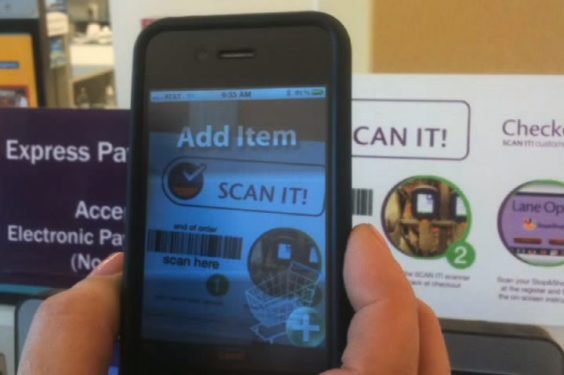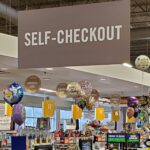You’d never dream of sticking something into your pocket and walking out the door of your local store. But would you ever casually “forget” to pay for something in your shopping cart, if you knew no one was watching? Surely not, you’re probably thinking. But given the opportunity, researchers say many of us would indeed do just that.
Their conclusion comes as retailers increasingly introduce self-payment technologies that allow you to pay – or not pay – for your purchases without any help from a cashier.
“What could possibly go wrong?” asked British professor Adrian Beck, co-author of a new report on the risks of self-payment. “Well, our research found that quite a bit could and does go wrong, with some potentially rather worrying long-term consequences.”
Beck and co-author Matt Hopkins are criminologists with the University of Leicester. In their newly-published report “Developments in Retail Mobile Scanning Technologies: Understanding the Potential Impact on Shrinkage and Loss Prevention,” they argue that allowing people to pay for their own purchases is practically an invitation to steal stuff.
Just look at what happened with self-checkout. That was once a much-hyped new technology that was considered a great cost- and time-saver. But many stores ultimately got rid of self-checkout stations, citing concerns about theft.
And now, the same might be happening with self-scanning and self-payment systems, which allow shoppers to scan products and pay for them using their mobile phones. A few stores currently offer the capability, though it’s not widespread just yet. And for good reason, the report’s authors say. “Retailers could find themselves accused of making theft so easy that some customers who would normally, and happily, pay are tempted to commit crime,” their report reads.
The researchers found “very high levels of loss” associated with self-payment systems, 122% higher than the average rate of loss. They argue that shoppers’ sense of risk perception is reduced, when human interaction is removed from the shopping process.
And if caught, some shoppers are ready with excuses. They blame problems with technology, faulty bar codes, or they just play dumb, claiming not to be technically proficient. “It is difficult for retailers to identify whether customers intended to non-scan items, or if they were simply absentminded or poor at scanning items consistently,” the report reads.
Walmart has dabbled in self-payment technology, but it has plenty of experience with self-checkouts. Its infamous method of preventing theft involves having “greeters” check your receipts on the way out of the store.
But the authors of a separate study on mobile self-payment say receipt-checking can defeat the very idea and appeal of being able to do it all yourself. A 2014 University of Arkansas report found that “exit inspections and other quality audits need to be carefully designed… in order to avoid eroding customer satisfaction.”
And shoppers who participated in that study agreed. “There’s no need to harass customers as they leave the store,” one commenter told researchers. “The paranoia about shoplifting and exit checks in this survey is disconcerting and I would not like to shop at a store with this level of disrespect for the consumer.” Added another, “I think the notion that customers will steal if they think they can get away with it, is insulting.” A third shopper vowed never to submit to exit checks. “I would instantly stop using any store that had exit inspections anywhere. If mobile shopping becomes a thing, I would 100% rather just online shop for groceries.”
Ultimately, it’s the honest shoppers who are most likely to be inconvenienced, while determined thieves will somehow find a way to get away with it. The question is whether the benefits of offering mobile payments are worth the risks to retailers. “All innovations in retailing are a business choice, hopefully done to make the shopper happier and the business more profitable,” Hopkins said. “But those same choices can also produce negative outcomes as well.”
With receipt inspectors and bag checks, it can sometimes seem that the easier it becomes to do it yourself, the more of a hassle the whole process turns out. In the end, going through a checkout lane and paying a cashier the old-fashioned way, may not be such a bad choice after all.
Image source: Stop & Shop

















It would be interesting to see what supermarket retailers say. When self scanning (scan and bag your groceries as you shop) first came out, a few retailers actually reported negative shrink rates as many customers were double scanning items or would later take an item out of their cart but not remove it from the scanned list.
This system is just a new way to implement an old technology. When Food Lion first introduced its Bloom concept in NC, its initial plan was to have self scan in all the Bloom locations. The system worked by being issued a key chain barcode just like loyalty cards. You chose a cordless handheld scanner very similar to those used at Sam’s or Costco, scanned your barcode and off you went. The rules were clearly explained when you signed up for the key tag. You would usually pay and go, but you would randomly be selected by the POS system to be audited and a cashier would re-ring all your purchases. If there was a discrepancy, the POS system kept track and you would be subject to more frequent audits for a certain period of time. If “discrepancies” were a constant problem, you would no longer be allowed to participate in self scan. The pros of the system was convenience and a BIG time saver–once the system had enough data to figure you weren’t a shoplifter, you were rarely audited. The cons were the initial learning curve for the scanner as far as how to remove items you didn’t want or accidentally scanned twice, as well as learning how to use and generate scannable labels from the produce scales. You didn’t need a separate loyalty card…the price tags reflected the sale price rather than the “price with card” seen in nearby Food Lion stores…due to you having the scanner key tag that tracked your buying habits already…with the added advantage to the store of having your accurate name, address, and phone number. The customer service reps signed you up for the key tag and you had to produce a government ID.